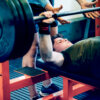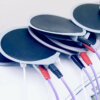Electrical muscle stimulation is widely used in the world of physiotherapy. But could it be a viable alternative to conventional resistance training for those looking to grow muscle and get stronger?
Overview
What did they test? The authors reviewed the current literature on electrical muscle stimulation and strength gains in healthy adults.
What did they find? They found that electrical muscle stimulation led to significant strength gains, although “terms and conditions apply”.
What does it mean for you? The currently available evidence on electrical muscle stimulation is limited, but it seems like electrical muscle stimulation may be useful as a supplement to conventional resistance training or an alternative modality for strength gains for those who are injured.
What’s the Problem?
Electrical muscle stimulation (EMS) has been used as a muscle-strengthening method in the physical therapy world but has also made its way into mainstream fitness in the past few years 1, to the point where there are dedicated fitness brands that offer solely EMS based training.
But how does EMS work?
EMS involves applying intermittent electrical stimulation to muscles via the use of surface electrodes, which in turns results in muscular contractions that respond to the intensity of the stimulation, imitating the natural process of muscle contraction.
There is previous literature to suggest that, indeed, EMS may be effective in preserving muscle mass loss after long periods of immobilization 2 and even assisting in certain muscle-related injuries. Furthermore, EMS has even been shown potential to be a solid supplement exercise to resistance training in rehabilitation. Additionally, and more interestingly, there is evidence to suggest that EMS may even lead to similar isometric strength gains when compared with “conventional” strength training even in trained individuals, training volume is matched 3.
However, it is somewhat difficult for studies to compare and contrast results given the lack of standardization in EMS protocols, and although EMS is used frequently in sports, it is not as common to see or hear about in the context of training for healthy adults. I believe that its “too-good-to-be-true” nature and the misconception that you could just sit on the couch and get fitter may have created a bit of a barrier to trying it for certain recreationally active individuals. Additionally, its extensive use in physiotherapy may have created an association between EMS and rehabilitation affecting people’s perception of EMS as another potential training modality.
So, is EMS just appropriate in the context of physiotherapy and inactive individuals, or is it something you could potentially utilize alongside your resistance training or even as a singular modality without the need for any "conventional" resistance training?







